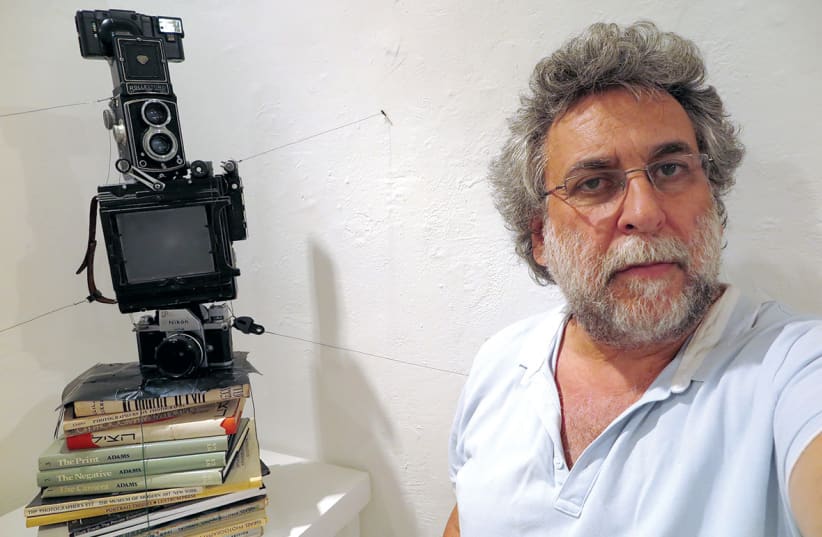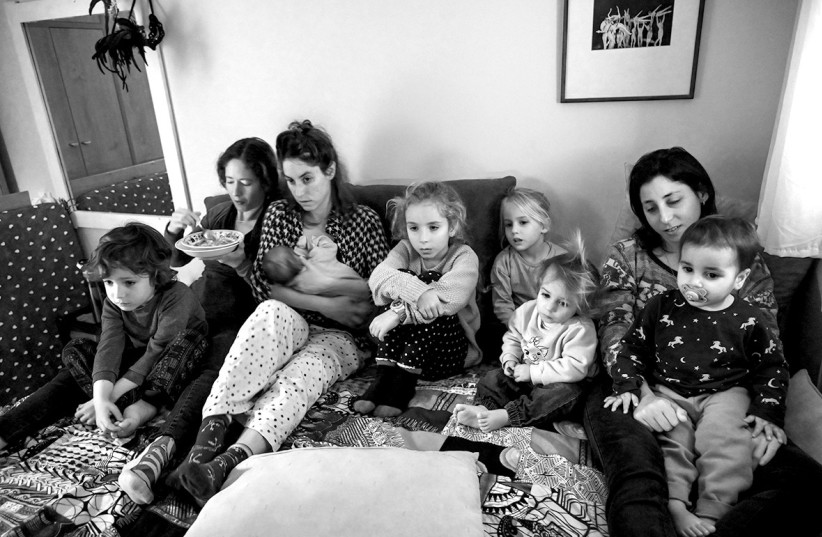Over the years Doron Adar has learned to roll with the punches. Listening to him talk about his life as an artist, photographer, husband and proud father and grandfather, you get the impression that he has “been there and done that” and probably taken a snap of each and every event and person he encountered on the way.
That notion is underscored by the works currently affixed to the walls of the Agripas 12 gallery. They cover a temporal arc of over 40 years, taking in some momentous life-changing events, birth, death and much betwixt.
The exhibition is called Deconstructing Agripas, which spells out part of Adar’s thinking behind the venture. The spread fashioned by curator Alejandra Okret duly imparts a pertinent sense of division, reshaping and redefinition, with numerous lines and points of reference throughout.
Deconstructing Agripas: Division, reshaping, dedefinition
“Construction is the assembling of parts, ideas and materials to create something new,” Okret posits in her exhibition notes.
She cites an earlier school of thought: “In art, construction evokes constructivism, a Russian movement that transformed the art world at the beginning of the last century. Its echoes are everywhere, the illusion of creating something different, crude and bold without artifice or manière.”
Nicely put. That no-nonsense direct ethos is everywhere you look across Deconstructing Agripas. We are introduced to Adar’s wife and her – successful – battle to overcome cancer. We also meet Adar’s children and their children and partners presented in intimate – posed and otherwise – portraiture. And one wall is festooned with dozens of small prints of characters whose paths have crossed Adar’s over the years. Yes, this is all about Adar, his persona and what brought him to where he is today. The 68-year-old photographer is clearly intent on putting his biographical effects in order.
There are poignant, smile-inducing, disturbing and entertaining vignettes all over the show. One of the most touching junctures is the pictures that feature Adar’s wife, Tzila, who underwent surgery and substantial medical intervention to recover from breast cancer. One large portrait shows her, almost completely naked, with some dabs of gold in strategic positions. The work originally saw the public light of day as part of Adar’s I’m Doing Fine exhibition, at the Agripas 12 gallery, back in 2015.
“There were five pictures like this, full size, Tzila’s actual height of 1.52 meters,” the artist notes. The idea was to bring us face-to-face, almost literally, with her, with a little aesthetic augmentation.
The gold dabs remind one of the Japanese custom of kintsugi, a traditional repair method that takes the broken or chipped parts of prized pottery vessels, glues them back together with a Japanese lacquer and paints the seams with gold or silver powder. The idea is both to beautify the breaks and to accentuate rather than conceal them. That suits the warts-and-all Adar portrayal approach.
“I added a sort of paraphrase here by covering the scars with gold,” he explains.
I noted that quite a few artists here seem to be adopting and adapting that line of aesthetics in recent times. Back in February, I caught a mixed media-photography exhibition, at the Contemporary Art Center in Ramle with works by Anna Hayat and Slava Pirsky which featured various corrective elements, including of the golden variety.
While Adar clearly embraces the philosophy behind the Japanese remedial artistic complement he says he has taken it as far as he wants to, at least for now.
“People are looking for something curative,” he muses. “I don’t think I’d like to do a whole exhibition about kintsugi, but here it suited the subject matter well.” The sensorial viewing experience is enhanced by the odd textual slot, including a poem by Adar’s daughter Rony, which sheds light on her father’s view of life, and his art form and opens with a moving stanza: “My father is sensitive to my sensitive eyes. He makes sure he buys me quality sunglasses. That is probably because he has sensitive eyes with which he documents the light within the darkness.”
That has both a physiological side and a father-daughter relationship aspect. Rony, who I was told by a proud dad was due to receive her PhD in Biology that very day, has some sight issues and Adar himself, not so long ago, had surgery for a problem he had in one eye. In medical lingo, the condition is called a macular hole, a rare complaint that can blur the central vision. The macula is a small area in the center of the retina.
True to his direct take on life and his art, Adar presents that to us front and center in a tetraptych which, it transpires, also has a professional bio slant to it.
“When I saw this I thought I’ve already done something like that,” he smiles as we face a four-parter with inverted crescent-like curves at various angles. One says “Macular hole, OCT.”
The initials stand for optical coherence tomography, a test used by ophthalmologists to detect optic nerve disorders. The original medical image was tiny – in the nanometer league – and Adar enlarged it to make the arc shape easily apparent to the viewer and fuse neatly with several landscapes he captured of similarly-shaped terrain over the years.
Unsurprisingly, Adar sees most things through an imaginary, or actual, camera lens. That sixth sense clicked in when he saw the OCT imagery shot. “When I saw this I thought I know this shape, I’ve done it before. This one’s from the Judean Desert, and this one too,” he says indicating the monochrome medical print’s neighbors on the wall. “I’ve taken pictures of this shape in Iceland, all over the place.”
THE EXHIBITION header comes with a bio-explanatory subtitle – 12 Years of Art at Agripas 12. Since he joined the cooperative, in 2011, Adar has exhibited at the cozy backstreet venue around half a dozen times, as well as contributing to creative joint ventures with the other members of the group. All his colleagues in the venture appear in the multifarious collage wall assemblage, along with other characters who have made a point of dropping in at the gallery, with one shot of Adar in the mix.
Now seemed as good a time as any to doff his beret to his buddies and others who have proffered support along the way.
“This is a sort of homage to the members of Agripas, things that have happened here, and the Marie Gallery next door, and other artists. Everyone here is an artist.”
It is also the result of Adar’s penchant for documentation: “I often take pictures of people I meet. These are people whom I meet momentarily, sometimes for longer,” he notes taking me in the direction of an intriguing shot.
“There is this fellow, for example,” Adar says with a smile. “I really like this photograph.” The gent in question is clearly a religious Jewish young man whom one might not readily associate with the exhibition visitor crowd. “He is a regular at the exhibitions here. He lives in the neighborhood. He is big. He fills the whole frame.” His uniformly black garb also nicely sets off the white walls and doorway.
We return to the deconstruction theme. While we chat and do the rounds of the gallery spaces, a video work on a screen that obscures the windows and glass-paned door to the small balcony, shows how Adar disposed of works from a prior exhibition.
The pictures were affixed to two circular pillars – much like the old street side noticeboards that can still be seen at various urban locations – and Adar decided to simply dump them after the show closed. The video storyline imparts a sense of letting go, of denying the ego and dispensing with objects that, in the cold light of day, are just material stuff.
The family-themed exhibits – and there are quite a few in there – tell a story. Motherhood and childhood are recurrent topics, as well as Doron and Tzila’s relationship and how Tzila’s health woes affected them as people and as a couple. There is a darkly humorous shot of Tzila and the Adars’ four children shot at home in the first days of the first Gulf War, in 1991.
“We had all this ridiculous business of using masking tape and we had to put our youngest kid in a sort of protected crib. She hated it, poor thing,” says Adar. Shades of more recent times perhaps?
The wall opposite the collage set is dominated by three large monochrome prints of three young fathers cradling their very small offspring.
“That’s my son and sons-in-law,” Adar explains. “The grandchildren were born within two weeks of each other.”
It looks like a promo for an active fatherhood campaign and conveys an oxymoronic sense of tenderness and masculinity. The epexegetical quote there cites celebrated American photographer Sally Mann who notes that: “The things that are close to you are the things you can photograph the best. And unless you photograph what you love, you are not going to make good art.” Adar patently embraces that concept.
Adar’s late mother also gets a slot in the show, albeit in her absence. One picture he took shortly after she passed away features her armchair in a bare domestic setting. There is a deft balance of the interior gloom and the bright and breezy exterior of the balcony in the rear. That comes with another emotive quote, this time by former Magnum photographer David Alan Harvey: “Don’t shoot what it looks like. Shoot what it feels like.”
In the exhibition catalog Adar muses about the meaning of a life lived and whether any of the deceased’s transient presence on Earth resonates after they pass on.
“What remains after we cease to be? An empty chair, a draft of air gently blowing the fringes of the window drapes, silence within the void suffused with presence. Will anyone stay behind to watch and document our absence?”
Existential issues abound in Deconstructing Agripas. There is a lot of summation about the exhibition, which runs through to July 8.
“It is a sort of looking inwards within a process which you are constantly undergoing,” Adar observes. “That is life and art. With me, they go hand in hand.”
Is it time for Adar to look back, at his life and work? That seems a trifle morbid but Adar sees his personal continuum as raw material for further creative endeavor.
“It is always a good idea to reflect,” he says with just a shimmer of a smile. ❖
For more information: agripas12gallery.com/













